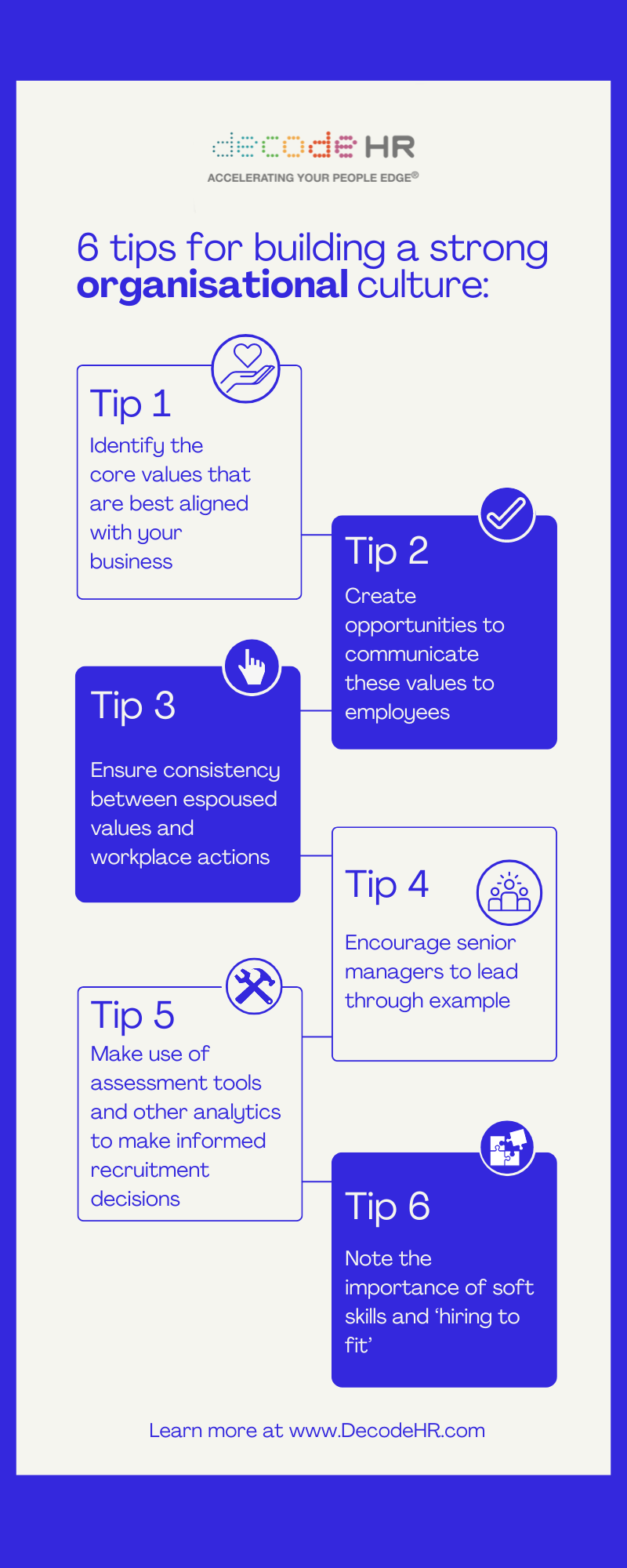Does Your Corporate Culture Attract or Repel Talent?
Reading time: 5 mins
Consistent workplace values and a strong organisational culture attract talent. Here are four questions that point to how strong your culture strategy is.
Picture of employees in a collaborative corporate culture.
1. Does your business have a clear sense of cultural identity?
More organisations are becoming increasingly aware of the importance of workplace culture. However, Evelyn Chow, DecodeHR’s managing director, said that few consider it necessary to put in place target goals and desired outcomes.
It takes deliberate effort to create a strong organisational culture, said Evelyn, and the first step towards achieving this is for businesses to have a clear idea of what they aspire to be.
She said, “They should at least have gone through the initial process of thinking and sharing about it with their teams before crystalising and communicating these aspirations to the external stakeholders. There must be a good understanding of both the employees’ and the leaders’ preferences and motivations within the organisational culture.”
2. Are your workplace actions consistent with the espoused values of the business?
Senior managers and leaders within a business have a large role in influencing the organisational culture of the workplace. They should lead by example, through authentic interactions with both internal and external stakeholders, and their actions should ideally be guided by organisational values and principles.
Some of these can be very intentional ways of demonstrating and living out the organisational culture, said Evelyn. Town hall sessions, day-to-day meetings, team and project meetings, as well as how success is celebrated within the company, for example, are ways to set the direction and shape the behaviours that are consistent with the business’ desired values.
Yet, good news is easy to handle, said Evelyn. Dealing with failure, on the other hand, is where things can get tricky. She said, “An organisation cannot claim to value innovation and risk taking, only to backtrack on this simply because mistakes were made, experiments had failed or pitches were lost. Leaders should also learn to open up and share about what they could have done better if they want to encourage open communication, and if a culture of trust is valued.”
3. How aligned are your employees to existing company values?
When individuals identify with existing workplace values, this is more likely to lead to long-term commitment and engagement, said Bob Chia, business development director of Talent Data Labs, which operates a hiring and human resource analytics platform. This, however, can only occur when there is a good cultural fit between employees and the organisation.
In addition, it is only when employees are aligned in their values and beliefs that they can build a strong organisational culture within a business. This, in turn, creates resilience. “A resilient organisation is a cohesive and high performing organisation, said Evelyn of DecodeHR. “They weather storms better together because they work as a team, and they co-ideate more effectively.”
4. Do your recruitment efforts focus on “hire to fit”?
The concept may feel somewhat intangible and difficult to measure, but the organisational culture of any business can be summarised into a few of its most important values. Some organisations use assessment tools as an additional data point (usually amongst others) to assist with their talent selection process.
Employees who fit well within the organisational culture are more likely to stay. Gallup’s State of the American Workplace report says that highly engaged business units achieve 59 per cent less turnover.
“Building a strong culture builds a multiplier effect on your talent acquisition strategies,” said Bob. “Stronger cultures and better cultural fit result in increased tenure, which means fewer individuals leave their jobs and you’ll need to hire fewer people.”
The building of the culture of an organisation must be intentional and not left to grow on its own lest it becomes too unwieldy to shape, noted Evelyn. “Take time to nurture a culture that will encourage people to be the best version of themselves and don’t give up because doing the right thing can sometimes be hard. But the results will more than often speak for themselves.”

Infographic by DecodeHR.
SHARE THIS INFOGRAPHIC ON YOUR WEBSITE
Copy the code in the box below and paste it into your page editor to embed it on your website.
<p><a href="https://www.decodehr.com/news-and-insights/does-your-corporate-culture-attract-or-repel-talent"> <img src="https://images.squarespace-cdn.com/content/5cfede4c6f0e8400015823cf/b0e27a04-1c55-4488-9f4f-7fb0d562959c/6+tips+for+building+a+strong+culture.png?content-type=image%2Fpng" alt="6 tips for building a strong culture" title="Infographic on 6 tips for building a strong culture" width="700" border="0" /> </a></p> <p>Infographic by <a href="https://www.decodehr.com/" target="_blank">DecodeHR</a>.</p>
Read part 1 of this article here.
Find out how to better align your company culture with your hiring strategy. Contact our team now.






